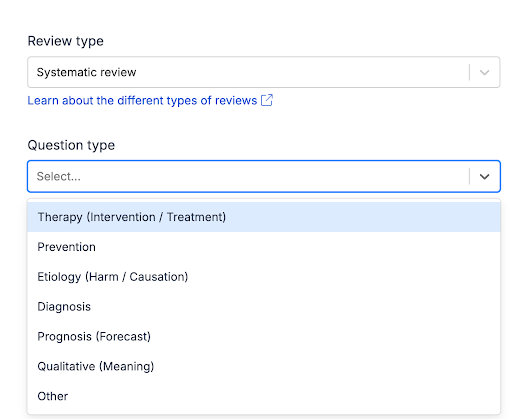Intervention reviews play a crucial role in evaluating the effectiveness of specific treatments, programs, or approaches. But how do intervention reviews relate to systematic reviews? Are they the same? Let’s break it down.
Are Intervention Reviews and Systematic Reviews Different?
A systematic intervention review is one that follows a structured, transparent process to evaluate the impact of a specific intervention, minimising bias and providing reliable insights.
On the other hand, a non-systematic intervention review—such as a traditional literature review—takes a more informal approach to gather and summarise research, which may not be as thorough or structured. For Covidence purposes, the term “systematic” refers to the review type, while “intervention” refers to the question type being studied.
It’s also important to note that not all systematic reviews evaluate interventions. A systematic review can focus on many types of questions, such as diagnostic accuracy (e.g., cancer screening), which is not an intervention but still benefits from a systematic approach to gather and assess the evidence.
So, when we talk about “intervention reviews,” we often mean systematic intervention reviews, which combine both aspects—being structured and focused on interventions.
What is an Intervention Review?
An intervention review, at its core, assesses how well a particular treatment or program works by systematically examining the impact on specific outcomes. These reviews aim to answer focused questions like:
- Does this medical treatment improve patient outcomes?
- How effective is this educational program in enhancing student performance?
- What is the cost-effectiveness of this intervention?
These reviews are critical for informing decisions in healthcare, education, public health, and beyond. By narrowing in on the effectiveness, safety, and cost of specific interventions, these reviews help practitioners and policymakers make evidence-based decisions about what works best.
Why Intervention Reviews Matter
In fields like healthcare and public health, intervention reviews are invaluable. They provide clear, evidence-based answers about whether a treatment or strategy is worth implementing. For instance, doctors use intervention reviews to determine which medications or therapies are most effective for different conditions. Policymakers rely on them to allocate funding for programs that have proven success.
How Covidence Facilitates Intervention Reviews
Covidence is a powerful tool designed specifically to streamline the process of conducting systematic and intervention reviews. Here’s how Covidence supports researchers in performing intervention reviews effectively:
- Streamlined Screening and Selection: Covidence simplifies the screening process by allowing researchers to upload studies, collaborate with team members, and systematically screen articles against predefined inclusion criteria. This ensures that all relevant studies are included while minimising bias.
- Data Extraction and Synthesis: Once studies are selected, Covidence facilitates efficient data extraction and synthesis. Researchers can extract key information such as study outcomes, intervention details, and methodological quality using standardised forms, ensuring consistency and accuracy in data collection.
- Risk of Bias Assessment: Assessing the risk of bias is critical in intervention reviews to evaluate the quality and reliability of included studies. Covidence helps users to assess risk of bias according to established guidelines, helping researchers interpret findings with confidence.
- Preparing for Meta-Analysis: For intervention reviews that include meta-analysis, Covidence is interoperable with RevMan. This saves time and duplication of effort by enabling researchers to produce a visual synthesis of intervention effectiveness in RevMan using data extracted in Covidence.
- Collaboration and Accessibility: Covidence enhances collaboration among team members by providing a centralised platform for project management, real-time updates, and discussion. This collaborative environment fosters transparency and efficiency throughout the review process.
Whether you’re exploring healthcare innovations, educational initiatives, or social programs, intervention reviews conducted using Covidence play a pivotal role in translating research into practice and improving outcomes.

Click here to go back to Covidence Academy.
Already have an account? Sign in and start screening!
Explore more resources.


